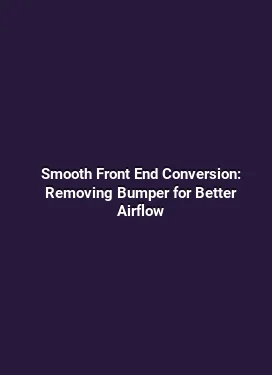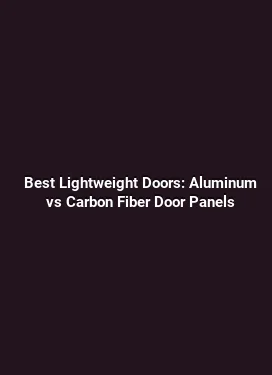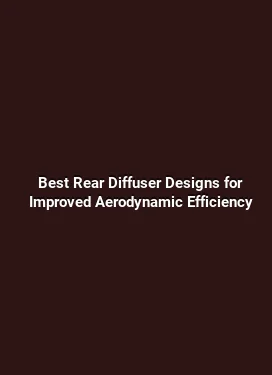How to Install a Vented Hood for Better Engine Bay Heat Extraction
In the realm of vehicle dynamics and performance, managing under-hood heat is a critical factor that influences engine efficiency, component longevity, and even aerodynamic behavior. A vented hood is a practical modification designed to enhance heat extraction from the engine bay by directing hot air out of the under-hood cavity and improving overall airflow. This guide dives into the physics of heat removal, the selection criteria for a vented hood, and a detailed installation process with real-world considerations, measurements, and performance implications.
Understanding Ventilated Hoods and Heat Management

Engine bays generate substantial heat through the combustion process, exhaust routing, and auxiliary systems. When heat accumulates under the hood, it can elevate intake air temperatures, reduce throttle response, and place additional thermal stress on components such as intake manifolds, fuel rails, and electronics. A vented hood creates dedicated exhaust paths that facilitate buoyancy-driven air movement. This works in tandem with the vehicle’s existing cooling system to sustain stable operating temperatures during high-load scenarios like spirited driving, track sessions, or hot ambient conditions.
Key concepts in this domain include airflow optimization, pressure differentials, and heat transfer mechanisms. Vents act as egress points for hot air, reducing stagnation beneath the hood. Layered panel construction, heat shielding, and insulation in the hood design help minimize radiant heat transfer to the intake tract and surrounding components. The resulting improvement in heat extraction can indirectly support air density stability, which contributes to more consistent engine performance across a range of operating conditions.
Principles of Airflow and Heat Extraction

Airflow dynamics under a vented hood rely on a combination of natural convection and vehicle movement. As the car moves forward, ram air enters the grille area and pushes across the engine bay. Without proper venting, hot air tends to become trapped, creating a thermal blanket. Strategic vent placement, whether in the center, sides, or a combination, channels hot air toward the exhaust path behind the hoodline. This reduces the temperature gradient within the engine bay and helps the radiator and intercooler operate more efficiently by lowering the ambient hot air that can swirl around critical components.
Material selection for the hood influences airflow behavior and thermal performance. A lightweight, rigid construction minimizes parasitic weight while maintaining structural integrity during high-speed operation. Some vented hoods feature louvered or slotted designs that guide air smoothly out of the cavity rather than creating disruptive turbulence. It's essential to balance vent size with integrity; overly large openings may compromise hood stiffness and impact pedestrian safety or debris protection in certain environments.
Choosing the Right Vent Hood for Your Vehicle
The decision process for a vented hood involves compatibility, material choices, and how the hood integrates with existing aesthetics and aerodynamics. Compatibility extends beyond bolt patterns to hinge geometry, hood height, and clearance with under-hood components such as the wiper mechanism, hood latch, and insulation. A well-chosen hood preserves or enhances the factory silhouette while improving heat extraction efficiency and, in some cases, reducing front-end lift at high speeds through improved air management.
Material options range from high-strength steel and aluminum to composite fibers. Aluminum hoods offer a favorable strength-to-weight ratio, which can contribute to performance gains when paired with proper reinforcement. Composites can be shaped for optimized vent geometry and reduced weight, though they may require careful mounting to avoid flex under load. Finish options vary from OEM-like coatings to carbon fiber aesthetics, with functional considerations such as heat resistance and UV stability in mind.
Fitment and Compatibility
Before purchasing, confirm fitment with the specific model year, trim, and sub-variants. Some vehicles use unique hood profiles, hood pins, or reinforcement braces that affect how a vented hood can be mounted. Ensure that the hood aligns with the fenders and maintains consistent gaps around the edges. Check clearance with the hood latch, hood shocks, and any under-hood components that may shift with the new geometry. A precise fit minimizes rattling, wind noise, and hood flutter at highway speeds.
Compatibility checks should include hood alignment with the cowl area and the possibility of altering the front bumper or grille integration. If the chosen vented hood alters the vehicle’s natural aerodynamics, consider whether additional upgrades—such as a front splitter, side skirts, or a rear diffuser—are warranted to preserve or enhance overall stability and front-end grip.
Step-by-Step Installation Guide
Executing a vented hood installation involves careful preparation, methodical disassembly, and precise reassembly. Following a structured process helps avoid damage to body panels, electrical connections, and the latch mechanism. The steps below outline a practical approach based on typical mid- to full-size passenger vehicles, with notes that may apply to performance-oriented applications as well.
Preparation and Tools
Gather a clean working space, protective blankets or cloths to prevent marring paint, and the appropriate tools. Common items include socket wrenches, torque wrench, screwdrivers, pliers, panel pullers, and a soft mallet. In addition, have a gasket sealer or weatherstripping adhesive if the hood requires a new seal or weather-seal integration. It’s prudent to inspect mounting hardware from the kit for thread conditions, corrosion, and fitment accuracy. A torque specification sheet from the hood manufacturer is essential to ensure fasteners are tightened to the correct values, preserving structural integrity without over-torquing joints.
Disconnect the battery and ensure all electronic modules in the engine bay remain protected from dust and debris. If the hood features integrated LEDs or sensors, note their locations and disconnect any electrical connectors according to the manufacturer’s instructions to avoid damage during removal.
Removal of Stock Hood and Mounting New Hood
Begin by supporting the hood to prevent accidental closure. Remove hood shocks or struts if present, detaching them from the fenders. With help or a stable support system, lift the existing hood away from the hinges and place it on a padded surface. Inspect hinge pins and mounting surfaces for wear, cleaning the area before exposing the underlying structure. Remove the factory latch assembly if the vented hood requires a different latch or reinforcement bracket supplied by the kit. Keep fasteners organized, labeling them for reassembly according to their original positions.
Position the vented hood onto the hinges, aligning bolt holes with the factory mounting points. Start by threading a few fasteners by hand to verify alignment, then tighten incrementally in a cross-pattern sequence to distribute load evenly. Reconnect any latch or alignment components and check hood alignment with the fender lines and front edge. The hood should sit flush along the entire periphery with uniform gaps; minor adjustments can be made by loosening, repositioning, and retightening fasteners as needed.
Once the hood is securely mounted, reattach the hood shocks or struts and verify smooth operation through multiple test openings. Close the hood slowly to ensure the latch seats correctly and that there is no interference with the vent apertures or surrounding engine bay components. If gaps or misalignment persist, revisit hinge mounting or shims provided by the kit to achieve an even, uniform fit.
Sealing, Gaskets, and Finishing
Vented hoods often include gaskets or seals around the vent edges to mitigate water intrusion and reduce wind noise. Install these seals as directed by the manufacturer, ensuring they are pressed firmly into place without excessive compression. The hood’s exterior finish should be protected during installation with painter’s tape along edges to prevent accidental scratches. If the hood includes ram air scoops or ducts that connect to intake systems, verify that hoses or ducts are securely fastened and routed away from hot surfaces or interfering components.
Inspect the under-hood area for debris and ensure that vent openings remain unobstructed by insulation or heat shields. Reinstall any under-hood insulation that was removed or repositioned, taking care not to block vents or restrict airflow paths. A final check of hardware torque, latch operation, and the hood’s audible and tactile feedback when closed will help ensure long-term reliability and user satisfaction.
Optimizing Aerodynamics and Performance
Beyond heat extraction, the placement and geometry of vents influence the vehicle’s aerodynamic profile. Properly designed vented hoods can contribute to reduced under-hood pressure buildup, which in turn can decrease front-end lift at higher speeds. This effect complements other aero components such as splitters, canards, and diffusers that collectively shape the car’s downforce distribution and high-speed stability. It is important to approach vented hood installation as part of an holistic aero strategy rather than a standalone upgrade.
Maintaining and tuning the aerodynamics of a modified hood involves monitoring for unintended drag increases. If the vent design disrupts the smooth flow of air across the hood surface, it may induce localized turbulence that could reduce fuel efficiency or alter cabin noise characteristics. Selecting a vent design that channels air efficiently, with soft transitions between flat and vented sections, helps maintain smooth flow and predictable behavior in a range of driving conditions.
Maintaining Aerodynamic Benefits
Routine inspection of the vent openings for blockages, dirt, or debris is essential to preserve performance. In dusty or off-road environments, periodic cleaning prevents airflow constriction. For performance applications, consider periodic assessments of under-hood temperatures using infrared or thermal imaging tools to verify that heat extraction remains effective as the vehicle ages or as powertrain components are upgraded. If heat-soak becomes noticeable or venting efficiency declines, revisit vent geometry or insulation strategies to restore the desired balance between cooling and drag characteristics.
Additionally, upgrading cooling system components—such as radiator fans, intercoolers, or heat exchangers—can complement vented hood performance. A holistic approach that improves both airflow and cooling capacity ensures that heat extraction remains robust during sustained high-load events or in extreme ambient temperatures.
Real-World Scenarios and Practical Examples
Translating theory into practice involves examining how vented hoods perform across different driving contexts. In daily commuting, the gains may be modest but noticeable through steadier engine temperatures during afternoon heat or when climbing long grades. On track-focused builds, vented hoods can contribute to cooler intake charges and more consistent torque delivery, especially when combined with enhanced cooling paths and surrounding aero components. Case studies from enthusiasts illustrate the balance between weight savings, rigidity, and heat management achieved through thoughtful hood selection and precise installation.
Consider a scenario where a mid-size sports sedan receives a lightweight aluminum vented hood. The installation reduces under-hood temperatures by several degrees during repeated high-speed laps and reduces heat soak after exiting a straight run. The result is more predictable power output and a cooler, more stable engine bay environment that allows auxiliary systems—such as the battery and electronics—to operate within their intended tolerances. For a street-oriented hot hatch, a carbon fiber vented hood may deliver a similar thermal improvement while preserving the visual appearance that harmonizes with the car’s aggressive stance and lighter weight profile.
Car Showcase: Vented Hood Benefits in Action
In practice, owners who pair a vented hood with a properly designed intake system, upgraded intercooler or radiator, and appropriate heat shielding often experience a multi-faceted improvement in thermal management. The hood vent acts as a crucial outlet that complements upgraded cooling paths, helping prevent temperature spikes during boost-heavy driving. This combination leads to more consistent turbocharger behavior, reduced probability of detonation under sustained heat stress, and a generally more linear power delivery profile overall.
Ultimately, the value of a vented hood lies not only in its ability to extract heat but also in how well it integrates with the vehicle’s overall aerodynamic and cooling strategy. Thoughtful attention to fitment, materials, and airflow paths yields benefits that extend beyond a single dimension, reinforcing reliability, performance, and driveability across a wide range of conditions.
Maintenance, Safety, and Longevity Considerations
Like any significant modification, a vented hood requires ongoing attention to ensure long-term reliability. Regular checks should include seal integrity, vent clearance, latch functionality, and hardware security. If the hood features active or integrated venting components, ensure that electrical connections and sensors remain protected from moisture and debris. Periodic inspection is also advisable for the hood’s supporting structure, especially where additional reinforcement or brackets were added to accommodate the vent design.
Weather exposure is a practical consideration. Prolonged exposure to gravel, road salt, or moisture can affect hardware corrosion and surface finishes. Address corrosion promptly by cleaning fasteners and applying appropriate protective coatings as needed. When removing or reinstalling the hood for maintenance or paintwork, follow the original torque specs and ensure static and dynamic load conditions remain within design tolerances to preserve structural integrity and performance characteristics over time.
Conclusion-Lite Narrative: Integrating a Vented Hood into Your Vehicle’s Profile
Adopting a vented hood is a meaningful step toward optimizing heat extraction and enhancing airflow within the engine bay. The true value emerges when the hood is selected and installed with careful regard for fitment, material properties, and the broader aerodynamic and cooling strategy of the vehicle. With precise installation, attention to detail, and a holistic approach to cooling and aerodynamics, a vented hood can deliver tangible benefits in thermal management, performance consistency, and even the tactile feel of engine responsiveness at elevated temperatures.
As with any performance-oriented modification, the outcome improves when supported by complementary upgrades that align with the vehicle’s intended use. A measured, data-informed approach—grounded in care for fitment, sealing, and airflow paths—helps ensure the modification enhances the vehicle’s dynamics without introducing unintended side effects. Through thoughtful selection, precise installation, and proactive maintenance, vented hoods become a practical tool in the arsenal of engine bay optimization and automotive aerodynamics.






